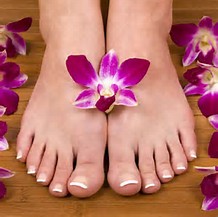




Skin Hygiene
Foot hygiene can become increasingly difficult as we age. For example, poor vision, arthritic habds, and poor balance can make it difficult to care for or even reach our feet. Simple tasks such as applying lotion, bathing feet, and especially trimming the toe nails can be extremely difficult.Those who cannot see or reach their feet must rely on family members or caregivers to assist with daily foot hygiene.
A European study suggested that poor foot hygiene was the first event in a gradual decline in foot health that ultimately leeds to foot pain and limited mobility.
Washing the skin on a daily basis is the first step in keeping the feet healthy. In addition, clean, comfortable socks and breathable shoes help to decrease the risk of fungal injections (e.g., athlete's foot), bacterial and viral infections between the toes, and foot odour.
Proper Cleaning of the Foot Involves Washing with soap and water
Drying skin thoroughly
Using powders, lotions, or typical antifugal medications as needed.
Moisturize dry skins with lotions, and treat dry, moist, or sweaty skin with powders. Treating athlete's foot or other fungal infections diligently with topical antifugals is especially important to minimize the risk of fungal nails. Finally, good foot hygiene requires good shoe and sock care.
Old shoes and unwashed socks can harbour bacteria and fungus. Wear a fresh pair of socks each day and replace cold, smelly, worn-out shoes. if you use a communal shower, such as at a health club, wear shower sandals to protect your feet against the funguses and bacteria that flourish on locker room floors.
Reference: Great Feet for Life: Paul Langer, DPM
